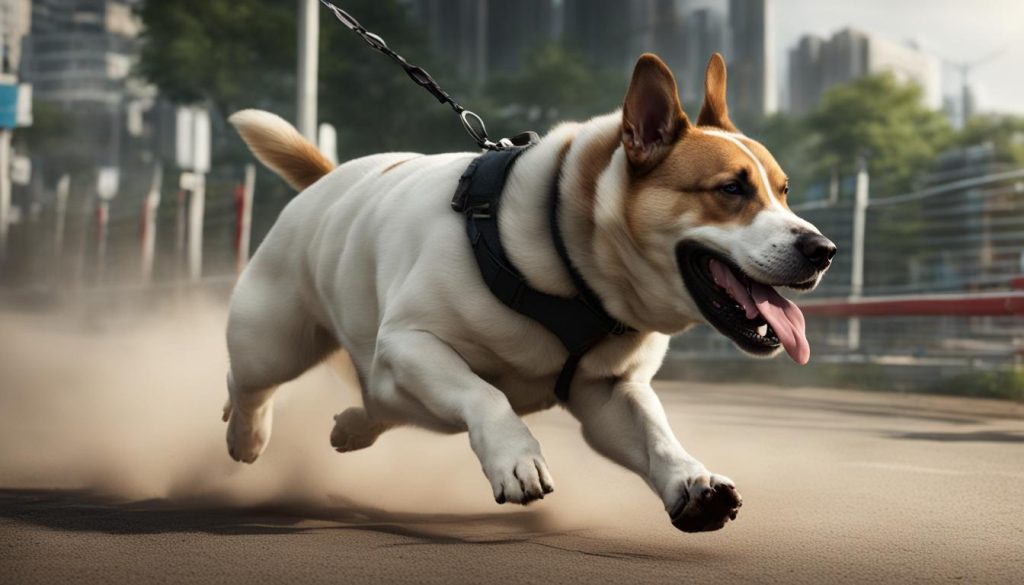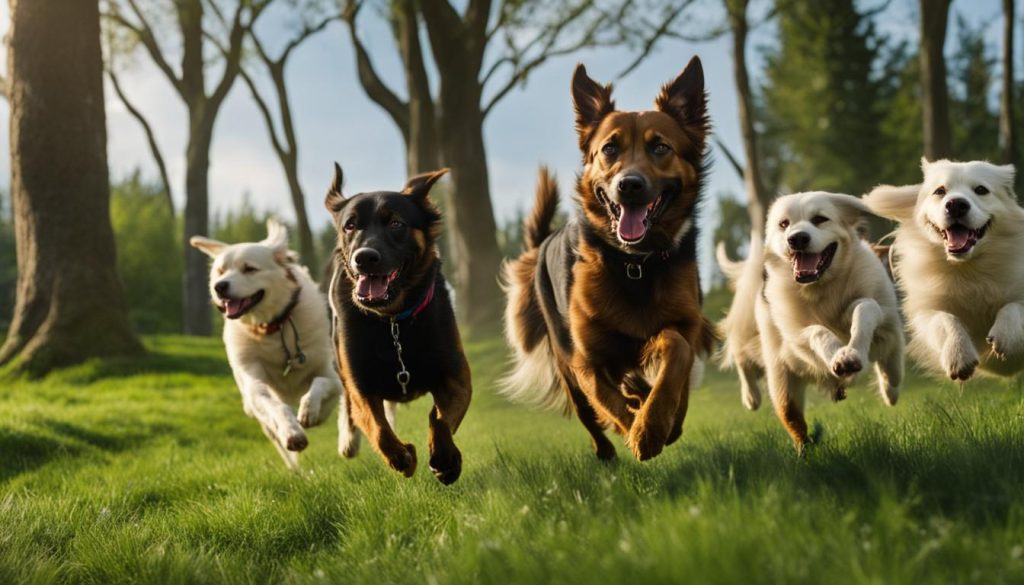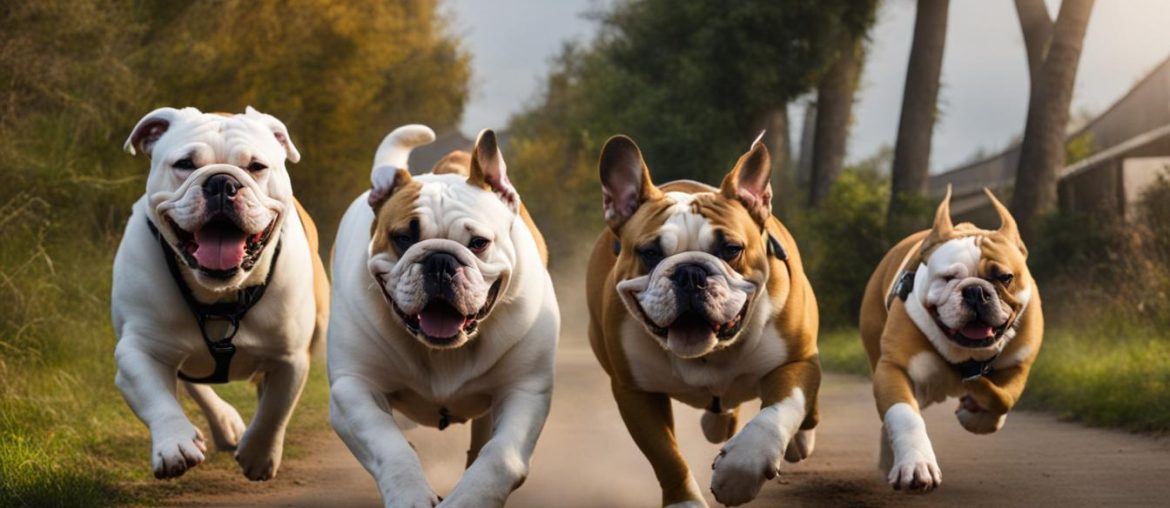A new study reveals a crucial link between the exercise habits of dog owners and the activity levels of their furry companions. As an active owner, it is essential to choose a dog breed that is suitable for running and has the energy to keep up. In this article, we will explore the worst running dog breeds, uncovering which breeds are unfit for running and not suitable for active lifestyles.
Key Takeaways:
- Not all dog breeds are suitable for running and high-intensity exercise.
- Low-energy dog breeds may not be a good fit for active owners looking for a running companion.
- Active owners should consider the breed’s energy level and exercise needs when choosing a dog for running.
- A study found a strong connection between the exercise habits of dog owners and their dogs.
- Some dog breeds are naturally athletic and have high energy levels, making them great running companions.
The Importance of Exercise for Dogs
Regular exercise is crucial for maintaining the overall health and well-being of dogs. Just like humans, dogs need physical activity to stay fit, prevent obesity, and reduce the risk of various health problems. Exercise not only helps dogs maintain a healthy weight but also promotes cardiovascular health, strengthens muscles and bones, and improves mental stimulation.
Obesity in dogs can lead to a range of health complications, including diabetes, joint problems, respiratory issues, and even certain types of cancer. To prevent these problems and ensure a happy and healthy life for our furry friends, it is essential to prioritize regular exercise as part of their daily routine.
The exercise frequency for dogs can vary depending on factors such as their age, size, breed, and overall health. The U.S. Department of Agriculture recommends a minimum of 30 minutes of exercise per day for dogs. However, more active breeds or larger dogs may require longer or more intense exercise sessions to meet their energy needs.

The Link between Exercise and Overall Health
Regular exercise not only helps dogs maintain a healthy weight but also has a positive impact on their overall health. Dogs that engage in regular physical activity have improved cardiovascular health, stronger muscles and bones, and a reduced risk of developing chronic conditions such as diabetes and heart disease. Exercise also provides mental stimulation for dogs, helping to alleviate boredom and reduce destructive behaviors.
exercise should be tailored to the specific needs of each dog. Puppies, senior dogs, and dogs with pre-existing health conditions may require modified exercise routines to ensure their safety and well-being. Consulting with a veterinarian can help determine the appropriate exercise plan for individual dogs.
A Holistic Approach to Canine Health
While exercise is a vital component of maintaining a dog’s health, it should be complemented by a balanced diet, regular veterinary care, and a safe and stimulating environment. Providing dogs with a well-rounded approach to their overall well-being will contribute to their longevity and quality of life.
Dogs That Are Not Suitable for Running
When it comes to choosing a running companion, not all dog breeds are created equal. Some breeds are known for their low energy levels and lack of enthusiasm for high-intensity exercise. These lazy or least active dog breeds may not be the best fit for active owners looking for a running buddy.
Low-energy dog breeds, such as Bulldogs, Basset Hounds, and Shih Tzus, tend to have a more laid-back and relaxed temperament. They may prefer lounging on the couch over going for a long jog. These breeds are not built for endurance and may quickly become tired or unable to keep up with an active owner’s pace.
It’s important for active owners to consider the energy level and exercise needs of different dog breeds before making a decision. While these low-energy breeds may not be suited for running, they can still make great companions for other activities such as leisurely walks or interactive play sessions that provide mental stimulation.
Table: Dog Breeds Not Suitable for Running
| Breed | Energy Level | Exercise Needs |
|---|---|---|
| Bulldog | Low | Moderate |
| Basset Hound | Low | Moderate |
| Shih Tzu | Low | Low |
Note: The table represents a few examples of dog breeds that are generally considered to be less suitable for running. It is not an exhaustive list, and individual dogs may vary in their exercise preferences and capabilities.

The Link Between Dog Breeds and Exercise Habits
A recent study involving over 3,000 dog owners from multiple countries has revealed a strong link between the exercise habits of owners and their dogs. The study found that dog owners who engage in regular exercise themselves tend to have dogs who also exercise more. This correlation suggests that the exercise habits of owners play a significant role in influencing the exercise routines of their furry companions.
Active owners are more likely to be mindful of their dog’s need for exercise and include them in their own exercise routines. Whether it’s going for a run, playing fetch, or taking long walks, active owners provide opportunities for their dogs to stay physically active. This not only benefits the dogs by keeping them healthy and fit but also strengthens the bond between the owner and their canine companion.
“The exercise habits of owners and their dogs are closely connected. Dogs are more likely to be active when their owners engage in regular exercise themselves.”
different dog breeds have varying exercise needs and energy levels. While some breeds are naturally more energetic and thrive on physical activity, others may have lower energy levels and require less exercise. Therefore, it’s crucial for active owners to choose a dog breed that aligns with their own exercise routines and can comfortably participate in their preferred activities.
| Breed | Exercise Needs | Activity Level |
|---|---|---|
| Labrador Retriever | High | Energetic |
| Bulldog | Low | Moderate |
| Border Collie | Very High | High |
| Pug | Low | Low |
| Golden Retriever | High | Energetic |
Choosing a dog breed that suits an active lifestyle ensures that both the owner and the dog can enjoy their exercise routines together. It’s a win-win situation that promotes a healthy lifestyle for both parties involved.

Breeds That Are Fit for Running
If you’re an active owner looking for a running companion, there are several dog breeds that are naturally athletic and have high energy levels. These breeds are known for their endurance and thrive on physical activity. Here are some of the most athletic, active, and energetic dog breeds that make great running partners:
Athletic Dog Breeds:
- Labrador Retriever
- Border Collie
- Siberian Husky
- Weimaraner
- Vizsla
These breeds are not only physically capable of running long distances but also have the energy to keep up with an active owner. They require regular exercise to stay mentally and physically healthy, making them ideal companions for runners.
“Labrador Retrievers are known for their athleticism and love for running. They have the endurance to keep up with long-distance runs and enjoy being active with their owners.”
When choosing a running partner, consider your own running pace and distance requirements. Some breeds, like Border Collies, excel at high-intensity sprints and agility training, while others, like Siberian Huskies, are better suited for longer distances. By selecting a breed that matches your running style, you can ensure a harmonious and enjoyable running experience for both you and your furry companion.
Table: Comparison of Athletic Dog Breeds
| Breed | Energy Level | Exercise Needs | Running Compatibility |
|---|---|---|---|
| Labrador Retriever | High | Moderate to High | Excellent |
| Border Collie | Very High | Very High | Excellent |
| Siberian Husky | High | High | Good |
| Weimaraner | High | High | Excellent |
| Vizsla | High | High | Excellent |
To put it simply, running with your dog is not only a great way to stay active and healthy but also strengthens the bond between you and your furry friend. Always consider the breed’s energy level, exercise needs, and running compatibility before making your decision. Happy running!

Factors to Consider When Choosing a Running Dog Breed
When selecting a dog breed for running, there are several factors to take into consideration. These factors include the breed’s energy level, exercise needs, size, age, and overall health. By evaluating these factors, you can ensure that you choose a breed that is well-suited for running and capable of meeting your exercise requirements.
Energy Level: The energy level of a dog breed is a crucial factor to consider when choosing a running companion. Some breeds, such as Border Collies and Australian Shepherds, have high energy levels and require significant exercise to stay content and healthy. On the other hand, breeds like Bulldogs and Pugs have lower energy levels and may struggle to keep up with the demands of running.
Exercise Needs: Each breed has different exercise needs that must be met to maintain their overall well-being. Some breeds thrive on frequent, high-intensity exercise, while others may require a more moderate exercise routine. Consider the recommended amount of exercise for the breed you are interested in and determine if you can commit to meeting those needs.
Size, Age, and Health: The size, age, and health of a dog can impact their ability to handle running and other forms of exercise. Larger breeds may have a higher risk of joint and skeletal issues, which could be exacerbated by excessive running. Similarly, older dogs or those with pre-existing health conditions may have limitations on their physical activity. I recommend that you consult with a veterinarian to assess if a particular breed is suitable for your running goals.

| Breed | Energy Level | Exercise Needs | Size |
|---|---|---|---|
| Border Collie | High | High | Medium |
| Bulldog | Low | Low | Medium |
| Labrador Retriever | Medium | Medium | Large |
| Chihuahua | Low | Low | Small |
Table: Comparison of energy levels, exercise needs, and sizes of different dog breeds
By considering the energy level, exercise needs, size, age, and health of a dog breed, you can make an informed decision when choosing a running companion. I recommend that you find a breed that aligns with your running pace and distance requirements, as well as one that can handle the physical demands of running without putting their health at risk.
Breeds That Are Not Recommended for Running
When it comes to choosing a dog breed for running, consider certain breeds that may not be suitable for high-intensity exercise. These breeds are prone to health issues or have physical characteristics that make them unfit for rigorous running activities. I highly suggest that you prioritize the well-being of your furry companion and choose a breed that can comfortably keep up with your fitness routine. Here are some breeds that are not recommended for running:
- Bulldogs: Known for their stocky build and short snouts, Bulldogs are not built for long-distance running. Their breathing can be compromised during intense exercise, putting them at risk for respiratory distress.
- Pugs: Similar to Bulldogs, Pugs have short noses and can experience breathing difficulties during vigorous exercise. Their compact bodies and shorter legs also make it challenging for them to keep up with a fast-paced running routine.
- Basset Hounds: With their low, elongated bodies and shorter legs, Basset Hounds are not built for running long distances. Their joints and back can be strained by the impact of running, increasing the risk of injuries.
These breeds may still enjoy shorter walks or light exercise, but avoid subjecting them to high-intensity running or prolonged endurance activities. Always consult with a veterinarian to determine the most suitable exercise routine for your dog’s specific breed and health condition.

Quotes:
“I recommend that you prioritize the well-being of your furry companion and choose a breed that can comfortably keep up with your fitness routine.”
Potential Health Risks of Running with Unsuitable Dog Breeds
Running with a dog breed that is not suitable for high-intensity exercise can pose various health risks and potential injuries. These risks can arise due to the physical characteristics of certain breeds or their predisposition to specific health issues. I recommend for active dog owners to prioritize their pet’s well-being and choose a breed that can handle the demands of running without compromising their health.
One of the health risks associated with running with unfit dog breeds is the increased likelihood of joint and skeletal problems. Breeds with existing joint or skeletal issues may experience joint pain, inflammation, or even permanent damage as a result of excessive running. For example, larger breeds are more prone to conditions like hip dysplasia, which can worsen with prolonged high-impact exercise.
Moreover, running with unsuitable breeds can also lead to respiratory difficulties. Some dog breeds, such as those with brachycephalic (short-nosed) features, have a higher risk of breathing problems, especially during intense exercise. These breeds may struggle to maintain proper airflow, causing them to pant excessively and potentially leading to overheating or collapse.
Additionally, running with unfit dog breeds can result in muscle strains, ligament sprains, and other musculoskeletal injuries. Breeds that are not built for endurance or have a more sedentary nature may not have the physical stamina or musculature to handle prolonged and intense exercise. Pushing these dogs beyond their limits can lead to acute injuries that may require medical intervention.
| Health Risks of Running with Unfit Dog Breeds |
|---|
| Joint and skeletal problems |
| Respiratory difficulties |
| Muscle strains, ligament sprains, and other musculoskeletal injuries |
You might want to consult with a veterinarian or a professional dog trainer to determine whether your chosen breed is suitable for running. They can provide valuable guidance on breed-specific exercise recommendations and help assess your dog’s overall fitness level. By making an informed decision and prioritizing your dog’s safety and well-being, you can enjoy running together while minimizing the potential health risks.
Considerations for Active Owners with Low-Energy Dog Breeds
As an active owner with a low-energy dog breed, find alternative ways to engage in physical activities together, even if running is not suitable. While your dog may not have the same stamina or energy levels as breeds known for their athleticism, there are still plenty of options to keep them active and mentally stimulated.
Shorter walks: Instead of long-distance running, consider shorter, more frequent walks. These walks can still provide exercise for both you and your dog while accommodating their lower energy levels. Focus on providing regular, structured walks that allow your dog to explore their surroundings and get some fresh air.
Interactive play sessions: Engage in interactive play sessions with your low-energy dog breed. This can include games like fetch, hide-and-seek, or playing with interactive toys that require mental and physical stimulation. These activities can help burn off excess energy and provide mental enrichment.
Mental stimulation exercises: Low-energy dog breeds often benefit from mental stimulation exercises. Consider puzzle toys or training sessions that challenge your dog’s mind. This can include teaching them new tricks, practicing obedience commands, or participating in scent work activities. Mental stimulation is just as important as physical exercise for these breeds.
| Physical Activities for Low-Energy Dog Breeds | Mental Stimulation Exercises for Low-Energy Dog Breeds |
|---|---|
| Shorter walks | Puzzle toys |
| Interactive play sessions | Training sessions |
| Swimming | Scent work activities |
| Hiking on easy trails | Problem-solving games |
To put it simply, every dog is unique, and their exercise needs may vary even within low-energy breeds. You should also observe your dog’s reactions and adjust their physical activities accordingly. Always consult with a veterinarian to determine the safest and most appropriate exercise routines for your specific dog breed.
By providing regular exercise and mental stimulation, you can ensure that your low-energy dog breed remains healthy and happy. Try to tailor the activities to suit their individual needs and capabilities. While they may not be able to keep up with high-intensity running, they still have a lot to offer as companions and can thrive with the right balance of physical and mental engagement.

The Link Between Owner’s Exercise Routine and Dog’s Exercise Routine
As a dog owner, my own exercise routine plays a crucial role in my dog’s exercise routine and overall health. I have noticed that when I prioritize my own physical activity, my dog becomes more active as well. This link between the owner’s exercise routine and the dog’s exercise routine has been confirmed by a recent study, reinforcing the importance of active living for both humans and their furry companions.
By incorporating exercise into my daily routine, I have been able to prevent weight gain in my dog and ensure that he maintains a healthy weight. Regular exercise not only helps to burn calories but also keeps my dog mentally stimulated and physically fit. It has become our bonding time, and I have seen firsthand the positive impact it has had on his overall well-being.
To prevent weight gain and obesity in dogs, it is essential for active owners to include their dogs in their exercise routines. This can be achieved through activities such as brisk walks, jogs, or even hiking. Finding activities that both the owner and the dog enjoy can make exercise more enjoyable and sustainable for both parties.
The Role of Diet and Feeding Practices in Dog Weight Control
Proper diet and feeding practices play a crucial role in controlling a dog’s weight and overall health. While exercise is important for weight management, it is equally important to provide a balanced and nutritious diet to ensure that dogs are getting the essential nutrients they need.
When it comes to feeding dogs, there are several factors to consider. The type of food, portion sizes, and feeding schedule all play a role in maintaining a healthy weight. I recommend that you choose a high-quality dog food that is appropriate for the dog’s age, size, and activity level. This can help provide the necessary nutrients while controlling calorie intake.
Feeding practices such as free feeding, where food is left out all day for the dog to graze on, can contribute to overeating and weight gain. Instead, it is recommended to establish regular meal times and portion control. This helps ensure that dogs are receiving the appropriate amount of food for their needs.
| Feeding Practices to Consider for Weight Control | Benefits |
|---|---|
| Scheduled meal times | Promotes portion control and prevents overeating |
| Portion control | Helps manage calorie intake and maintain a healthy weight |
| Feeding a balanced diet | Provides essential nutrients and prevents deficiencies |
| Avoiding table scraps | Prevents excessive calorie intake and potential health issues |
In addition to feeding practices, monitor a dog’s weight and make adjustments to their diet as needed. If a dog is overweight, reducing portion sizes or switching to a weight management formula can help promote weight loss. On the other hand, if a dog is underweight, increasing portion sizes or choosing a high-calorie formula may be necessary.
Regular exercise is important for dogs to maintain a healthy weight and overall well-being. However, please remember that exercise alone may not be enough to achieve weight loss or control. By combining appropriate feeding practices with regular exercise, dog owners can help their furry friends achieve and maintain a healthy weight.
Final Thoughts
To sum it up, it is crucial for active owners to carefully consider the breed characteristics, energy levels, and exercise needs of different dog breeds before choosing a running companion. Not all breeds are suitable for high-intensity exercise, and running with an unsuitable breed can pose health risks to both the owner and the dog.
By selecting a breed that is suitable for running and providing regular exercise, active owners can ensure the well-being and happiness of their canine companions. Avoiding the worst running dog breeds and choosing the right breed for running can help prevent injuries, joint problems, and other health issues associated with unsuitable breeds.
To put it simply, each dog is unique, and it is essential to consider their size, age, and overall health when deciding on the appropriate exercise routine. Consult with a veterinarian or a professional dog trainer to determine the best exercise plan for your specific breed and individual dog.
By making a well-informed choice and prioritizing the health and safety of your dog, you can enjoy the benefits of running together while fostering a strong bond with your loyal running partner.
FAQ
Are there certain dog breeds that are not suitable for running?
Yes, some dog breeds have low energy levels and are less active, making them unfit for running.
What are the potential health risks of running with unsuitable dog breeds?
Running with unsuitable dog breeds can increase the risk of injuries and health issues, such as joint pain and damage.
How should I choose a running dog breed?
When choosing a running dog breed, consider factors such as energy level, exercise needs, size, age, and overall health.
Which dog breeds are not recommended for running?
Certain dog breeds, such as flat-faced breeds, are not recommended for running due to their physical characteristics or predisposition to health issues.
What should active owners with low-energy dog breeds do?
Active owners with low-energy dog breeds can engage in other physical activities, such as shorter walks, interactive play sessions, or mental stimulation exercises.
Is there a link between the exercise habits of dog owners and their dogs?
Yes, a study found a significant connection between the exercise habits of dog owners and their dogs’ exercise routines.
How much exercise do dogs need?
The US Department of Agriculture recommends a minimum of 30 minutes of exercise per day for dogs, but the required amount can vary based on the dog’s size, age, and health status.
How can exercise help with weight control in dogs?
Exercise helps to burn calories, build muscle, and improve overall fitness, which contributes to weight management and the prevention of obesity-related health issues in dogs.






